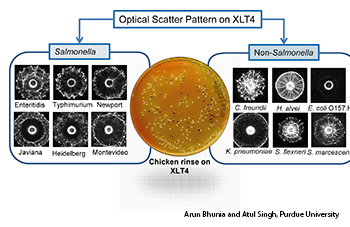
A BARDOT-generated portrait of the microbial community in a sample taken from raw chicken. BARDOT can differentiate Salmonella (left) from non-Salmonella (right) bacteria.
No one wants to get sick from salmonella and other food-borne pathogens. Scientists from Purdue University (U.S.A.) have used forward-scattering laser technology to identify salmonella bacteria more rapidly than other methods (mBio 5(1), doi:10.1128/mBio.01019-13).
Using a narrow laser beam, the researchers can identify serovars from smaller colonies of bacteria, which take less time to grow in a culture medium than larger colonies, according to Arun Bhunia, a food science professor at Purdue. Serovars are different “breeds” within a species of microorganism, based on surface antigens. Salmonella has thousands of different serovars, and distinguishing them from each other and from other species can help food inspectors.
Bhunia, postdoctoral fellow Atul Singh and their colleagues first grew bacteria rinsed off of chicken, peanut butter and spinach known to be contaminated. In 16 to 24 hours, the colonies in the culture medium grew to be about 1 mm in diameter.
The researchers then inserted the petri dishes into a tabletop instrument called BARDOT, for “bacterial rapid detection using optical-scatter technology.” The device sends a 1-mm-wide beam from a 675-nm-wavelength diode laser through the colonies and records the scattered light on a small camera. The Purdue team found that serovars of salmonella cast light patterns that were distinguishable from each other and also from non-salmonella bacterial species in the same medium.
Traditional methods of salmonella typing take up to 72 hours because they require larger colonies of bacteria to grow, Bhunia says.
A startup company has commercialized the BARDOT technology, but national agricultural regulator certification is still necessary in order to use it in industrial food inspection systems. Meanwhile, Bhunia and Singh are categorizing light-scatter patterns from other types of microorganisms that cause illnesses.
